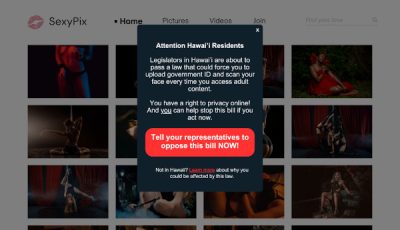Are Obscenity Prosecution Concerns Obsolete?
 Back in the late 90’s, when I first began working in the adult entertainment industry, I sat down for a meeting with an attorney to talk about a broad swath of legal issues facing my employer.
Back in the late 90’s, when I first began working in the adult entertainment industry, I sat down for a meeting with an attorney to talk about a broad swath of legal issues facing my employer.
The company I worked for was among the first video streaming services in the adult internet industry, and in addition to offering content we produced ourselves, we were signing content licensing deals as quickly as we could, seeking to expand our offerings across numerous niches and categories.
Over the months and years to come, the same attorney would occasionally review samples of content we were digitizing. One afternoon, he landed upon clip which literally made him gasp out loud. The producer/director of the source video was Max Hardcore – which, if you’re familiar with the name, probably gives you a good idea of how our attorney reacted.
“This…” he said, trailing off as his eyebrows climbed towards his hairline. “Well, this is problematic, to say the least.”
What ensued was one of many conversations we would have about obscenity law, the Miller Test and the continuous rumblings out of Congress about how ‘something must be done’ to address the growing ubiquity of online porn.
“Keep in mind that it’s not just illegal to produce content deemed obscene,” the attorney admonished me at one point. “It’s also illegal to distribute obscene materials – which means you guys could be on the hook for anything it streams by this ‘Max’ person, if a jury finds it obscene.”
Ultimately, the company decided to take the risk of streaming Max Hardcore’s content – or some of it, at least. We opted to split the difference between not carrying any of Max’s work and carrying all of it, omitting certain titles we thought were more likely to draw the ire of prosecutors than others.
At the time, the adult industry was not far removed from the last spate of vigorous obscenity law enforcement, which took place over a time frame that spanned the Ronald Reagan and George H.W. Bush Administrations. Back then, you couldn’t attend a legal seminar at an adult trade event without hearing extensively about the risks of being targeted in an obscenity prosecution.
While President Bill Clinton would eventually become better known for his own sexual exploits than as any sort of decency crusader, he did sign both the Communications Decency Act and the Child Online Protection Act, both of which aimed to rein in the proliferation of online porn.
Later came George W. Bush – and, more to the point where obscenity is concerned, Attorney General John Ashcroft, who reportedly had reinvigorating federal obscenity prosecutions high on his list of priorities, until the terrorist attacks of September 11 forced a major shift in focus for the entire U.S. government.
Back in those days, some studios, directors and distributors in the adult space used a kind of risk-avoidance checklist attributed to attorney Paul Cambria – appropriately nicknamed the “Cambria List” – as a guide for reducing the risk of prosecution.
Sitting here in 2019, years away from the last high-profile federal obscenity prosecution, it’s amazing how much things have changed in adult content production over the last 20 years. Looking over the bullet points on the Cambria List, it’s hard to imagine too many current adult content producers heeding guidelines like “no black men-white women themes” or “no transsexuals” or “no two dicks in/near one mouth.”
Late last year, when I asked Jeffrey Douglas, the Board Chair of the Free Speech Coalition (and veteran of several obscenity prosecutions as a defense attorney, including one in which his client was the aforementioned Max Hardcore), Douglas told me that there’s “almost no chance that there will be significant resources assigned to obscenity prosecutions” by the federal government, going forward.
“In the highly unlikely event that significant resources are assigned to prosecuting adult obscenity cases… the material would have to be at the extreme end of extreme,” Douglas added. “Jurors have experienced the proliferation of free sexually explicit materials on the Web. They are unlikely to be receptive to criminalizing materials that are available to everyone.”
Does this mean that adult content producers can forget about obscenity prosecutions? Are the concerns which caused Paul Cambria to author his famous list now entirely obsolete? It would be comforting if the answers to these questions was a solid and resounding ‘yes’ – but as with so many legal issues, the outlook on obscenity law simply isn’t so clear and convenient.
“Obscenity is still a relevant topic for legal advice to any adult industry client,” attorney Larry Walters recently told me – although he conceded that looking over the industry landscape and the content currently being produced, “it does appear that the industry as a whole has become less concerned with specific content restrictions, aside from some extreme fetishes and anything depicting lack of consent.”
“The Cambria List was a handy reference tool but was never intended as a comprehensive description of legal versus obscene content categories,” Walters noted. “Any type of adult content could be deemed obscene by some judge or jury, depending on the overall serious value of the material and the geographic jurisdiction bringing the charges.”
Walters also agreed that the declining relevance of guidelines like the Cambria list does flow, at least to some extent, from the government’s relatively laissez-faire attitude towards porn in recent years — but he also cautioned that one can never be certain the obscenity law enforcement pendulum won’t swing back in the other direction in the future.
“Some of the categories on the Cambria List have become common fare in the adult industry, largely based on the lack of regular obscenity prosecutions and evolving social mores,” Walters said. “However, this could change quickly if state or federal officials decide to try their hand at renewed prosecutions.”
Walters also observed that while the public’s disposition toward pornography may have shifted to greater acceptance and tolerance, there’s ample evidence that lawmakers haven’t followed suit.
“The new wave of state-level legislative resolutions declaring pornography to be a public health crisis may be an attempt to enhance the government’s ability to win obscenity prosecutions,” Walters speculated. “Presumably, the government would argue that the state has deemed the content to be dangerous to public health, and therefore it cannot have serious literary, artistic, political, or scientific value (i.e., one of the elements of the obscenity test). Whether any court or jury would accept such an argument remains to be seen, but some prosecutor may try. Ultimately, it is up to a judge or jury to decide whether a certain work is obscene, not some political body.”
Is it possible the government might try a slightly different tact than in years past, specifying certain sex acts as forbidden to depict, rather than relying on the vagaries of how a jury applies the Miller Test? Walters said such an approach likely wouldn’t survive the scrutiny of the courts.
“Any legal restriction on a specific category of adult content would almost certainly be struck down on First Amendment grounds,” Walters said. “The Miller Test remains the only judicially-approved method of determining whether sexually oriented content can be deemed obscene, and therefore illegal.”
What all this adds up to is a familiar ambiguity where the prospect of obscenity prosecutions is concerned – something which hasn’t changed since the early days of the adult internet space.
“In the end, state and federal obscenity prohibitions still exist and the industry must be prepared to defend any content it produces in the event a criminal charge is filed,” Walters said. “The likelihood of such charges in the current environment can be debated but the threat remains so long as the laws remain on the books.”













